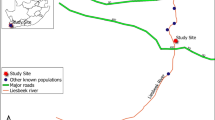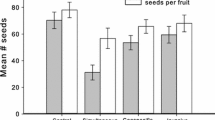Abstract
Invasive plants can impact biodiversity and ecosystem functioning by displacing native plants and crop species due to competition for space, nutrients, water and light. The presence of co-flowering invasives has also been shown to affect some native plants through the reduction in pollinator visitation or through the deposition of heterospecific pollen on the native’s stigmas leading to stigma clogging. We examined the impact of the invasive plant Solanum elaeagnifolium Cavanilles (silver-leafed nightshade), native to South and Central America and South-western parts of North America, on the seed set of the native Glaucium flavum Crantz (yellow-horned poppy) on Lesvos Island, Greece. To do this we measured seed set and visitation rates to G. flavum before and after the placement of potted individuals of the invasive near the native plants. In addition, we hand-crossed G. flavum flowers with super-optimal amounts of conspecific pollen, bagged flowers to measure the rate of spontaneous selfing, and applied self-pollen to measure self-compatibility of G. flavum. The hand-selfing treatment resulted in very low seed set, which indicates that G. flavum is to a large degree self-incompatible and highlights the plant’s need for insect-mediated outcrossing. We show that the presence of the invasive significantly enhanced pollen limitation, although the overall visitation rates were not reduced and that this increase is due to a reduction in honeybee visitation in the presence of the invasive resulting in reduced pollination.



Similar content being viewed by others
References
Aigner PA (2004) Ecological and genetic effects on demographic processes: pollination, clonality and seed production in Dithyrea maritima. Biol Conserv 116:27–34
Bartomeus I, Vilà M, Santamaría L (2008) Contrasting effects of invasive plants in plant-pollinator networks. Oecologia 155:761–770
Baye Y, Ameur A, Bouhaches M et al (2007) Strategy for the chemical control of Solanum elaeagnifolium Cav. in Morocco. EPPO Bull 37:145–152
Bjerknes AL, Totland Ø, Hegland SJ et al (2007) Do alien plant invasions really affect pollination success in native plant species? Biol Conserv 138:1–12
Boratynski A, Browicz K, Zielinski J (1992) Chorology of trees and shrubs in Greece. Polish Academy of Sciences, Sorus, Poznan/Kornik
Bouhache M, Tanji A (1985) Assessment of the stock of Solanum elaeagnifolium Cav. Yellow Nightshade seeds in the soil of the Tadla (Morocco). Weed Res 25:11–14
Boyd JW, Murray DS (1982) Growth and development of Silverleaf Nightshade (Solanum elaeagnifolium). Weed Sci 30:238–243
Boyd JW, Murray DS, Tyrl RJ (1984) Silverleaf Nightshade, Solanum elaeagnifolium, origin, distribution, and relation to man. Econ Bot 38:210–217
Brown BJ, Mitchell RJ (2001) Competition for pollination: effects of pollen of an invasive plant on seed set of a native congener. Oecologia 129:43–49
Brown BJ, Mitchell RJ, Graham SA (2002) Competition for pollination between an invasive species (Purple Loosestrife) and a native congener. Ecology 83:2328–2336
Brunel S (2011) Pest risk analysis for Solanum elaeagnifolium and international management measures proposed. EPPO Bulletin 41:232–242
Buchmann SL, Cane JH (1989) Bees assess pollen returns while sonicating Solanum flowers. Oecologia 81:289–294
Chapman MA, Forbes DG, Abbott RJ (2005) Pollen competition among two species of Senecio (Asteraceae) that form a hybrid zone on Mt. Etna, Sicily. Am J Bot 92:730–735
Chittka L, Schürkens S (2001) Metrology: successful invasion of a floral market. Nature 411:653
Chittka L, Thomson JD, Waser NM (1999) Flower constancy, insect psychology, and plant evolution. Naturwissenschaften 86:361–377
Chittka L, Skorupski P, Raine NE (2009) Speed-accuracy tradeoffs in animal decision making. Trends Ecol Evol 24:400–407
Cooley AW, Smith DT (1971) Silverleaf Nightshade (Whiteweed) establishment from seed and clipped seedlings. Progress Report of Texas A&M University, Texas Agricultural Experiment Station PR-3198
Economidou E, Yannitsaros A (1975) Recherches sur la flore adventice de Grèce, V, Distribution et écologie de Solanum elaeagnifolium Cav. Revue de Biologie et d’Ecologie Méditerranéenne 2:29–44
Eisikowitch D (1979) Horned poppy, Glaucium flavum. In Israel: notes on its pollination and distribution. Isr J Bot 28:87–94
Eleftherohorinos IG, Bell CE, Kotoula-Syka E (1993) Silverleaf Nightshade (Solanum elaeagnifolium) control with foliar herbicides. Weed Technol 7:808–811
EU (1992) Council Directive on the conservation of natural habitats and of wild fauna and flora 92/43/EEC, OJ L 206. http://eur-lex.europa.eu/LexUriServ/site/en/consleg/1992/L/01992L0043-20070101-en.pdf. Accessed 30 Sept 2011
Feldman TS, Morris WF, Wilson WG (2004) When can two plant species facilitate each other’s pollination? Oikos 105:197–207
Gathmann A, Tscharntke T (2002) Foraging ranges of solitary bees. J Anim Ecol 71:757–764
Grabas GP, Laverty TM (1999) The effect of purple loosestrife (Lythrum salicaria L.; Lythraceae) on the pollination and reproductive success of sympatric co-flowering wetland plants. Ecoscience 6:230–242
Greenleaf SS, Williams NM, Winfree R et al (2007) Bee foraging ranges and their relationship to body size. Oecologia 153:589–596
Holland JN, Chamberlain SA (2007) Ecological and evolutionary mechanisms for low seed:ovule ratios: need for a pluralistic approach? Ecology 88:706–715
Jacobi CM, Ramalho M, Silva M (2005) Pollination biology of the exotic rattleweed Crotalaria retusa L. (Fabaceae) in NE Brazil. Biotropica 37:357–363
Jakobsson A, Padron B, Traveset A (2008) Pollen transfer from invasive Carpobrotus spp. to natives—a study of pollinator behaviour and reproduction success. Biol Conserv 141:136–145
Kasagi T, Kudo G (2005) Interspecific pollinator movements and heterospecific incompatibility: comparisons between Phyllodoce caerulea and Phyllodoce aleutica along snowmelt gradients. Evol Ecol Res 7:73–87
Larson DL, Royer RA, Royer MR (2006) Insect visitation and pollen deposition in an invaded prairie plant community. Biol Conserv 130:148–159
Lopezaraiza-Mikel ME, Hayes RB, Whalley MR et al (2007) The impact of an alien plant on a native plant-pollinator network: an experimental approach. Ecol Lett 10:539–550
Mack RN, D’Antonio CM (1998) Impacts of biological invasions on disturbance regimes. Trends Ecol Evol 13:195–198
Matsumoto T, Takakura KI, Nishida T (2010) Alien pollen grains interfere with the reproductive success of native congener. Biol Invasions 12:1617–1626
McGuire A, Armbruster S (1991) An experimental test for reproductive interactions between two sequentially blooming Saxifraga species (Saxifragaceae). Am J Bot 78:214–219
Mekki M (2007) Biology, distribution and impacts of Silverleaf Nightshade (Solanum elaeagnifolium Cav.). EPPO Bull 37:114–118
Memmott J, Waser NM (2002) Integration of alien plants into a native flower-pollinator visitation web. Proc R Soc Lond B 269:2395–2399
Moragues E, Traveset A (2005) Effect of Carpobrotus spp. on the pollination success of native plant species of the Balearic Islands. Biol Conserv 122:611–619
Petanidou T, Den Nijs JCM, Oostermeijer JGB (1995) Pollination ecology and constraints on seeds et of the rare perennial Gentiana cruciata L. in The Netherlands. Acta Bot Neerlandica 44:55–74
Petanidou T, Godfree RC, Song DS et al (2012) Self-compatibility and plant invasiveness: comparing species in native and invasive ranges. Perspect Plant Ecol Evol Syst 14:3–12
Pimentel D, McNair S, Janecka J et al (2001) Economic and environmental threats of alien plant, animal, and microbe invasions. Agric Ecosyst Environ 84:1–20
R Development Core Team (2008) R: A language and environment for statistical computing, 2.8 edn. The R Foundation for Statistical Computing, Vienna
Ruane LG, Donohue K (2007) Environmental effects on pollen-pistil compatibility between Phlox cuspidata and P. drummondii (Polemoniaceae): implications for hybridization dynamics. Am J Bot 94:219–227
Spaethe J, Tautz J, Chittka L (2006) Do honeybees detect colour targets using serial or parallel visual search? J Exp Biol 209:987–993
SPSS (2006) Version 15.0 for Windows. LEAD Technologies, SPSS Inc. All rights reserved, Chicago
Tepedino VJ, Bradley BA, Griswold TL (2008) Might flowers of invasive plants increase native bee carrying capacity? Intimations from Capitol Reef National Park, Utah. Nat Areas J 28:44–50
Thanos CA, Georghiou K, Skarou F (1989) Glaucium flavum seed germination - an ecophysiological approach. Ann Bot 63:121–130
Thijs KW, Brys R, Verboven HAF et al (2012) The influence of an invasive plant species on the pollination success and reproductive output of three riparian plant species. Biol Invasions 14:355–365
Totland Ø, Nielsen A, Bjerknes AL et al (2006) Effects of an exotic plant and habitat disturbance on pollinator visitation and reproduction in a boreal forest herb. Am J Bot 93:868–873
Traveset A, Richardson DM (2006) Biological invasions as disruptors of plant reproductive mutualisms. Trends Ecol Evol 21:208–216
Tscheulin T, Petanidou T, Zografou C et al (2008) Invading the Mediterranean: study of Solanum elaeagnifolium, a successful invasive plant from C. America. Earth Conference. University of the Aegean, Mytilene
Tscheulin T, Petanidou T, Potts SG et al (2009) The impact of Solanum elaeagnifolium, an invasive plant in the Mediterranean, on the flower visitation and seed set of the native co-flowering species Glaucium flavum. Plant Ecol 205:77–85
Tscheulin T, Neokosmidis L, Petanidou T et al (2011) Influence of landscape context on the abundance and diversity of bees in Mediterranean olive groves. Bull Entomol Res 101:557–564
Vila M, Bartomeus I, Dietzsch AC et al (2009) Invasive plant integration into native plant-pollinator networks across Europe. Proc Roy Soc B Biol Sci 276:3887–3893
Wardle DA, Nicholson KS, Ahmed M et al (1994) Interference effects of the invasive plant Carduus nutans L. against the nitrogen fixation ability of Trifolium repens L. Plant Soil 163:287–297
Weihe PE, Neely RK (1997) The effects of shading on competition between Purple Loosestrife and Broadleaved Cattail. Aquat Bot 59:127–138
Acknowledgments
This research project was financed by the E.U.-European Social Fund (80 %), and the Greek Ministry of Development-GSRT (20 %). Financial support was also received from the Helmholtz Centre for Environmental Research (UFZ).
Author information
Authors and Affiliations
Corresponding author
Rights and permissions
About this article
Cite this article
Tscheulin, T., Petanidou, T. The presence of the invasive plant Solanum elaeagnifolium deters honeybees and increases pollen limitation in the native co-flowering species Glaucium flavum . Biol Invasions 15, 385–393 (2013). https://doi.org/10.1007/s10530-012-0293-y
Received:
Accepted:
Published:
Issue Date:
DOI: https://doi.org/10.1007/s10530-012-0293-y




